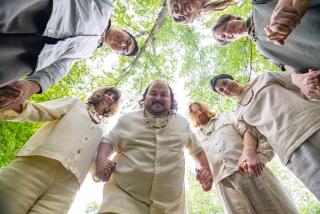Here’s why the outrageously important ‘Key & Peele’ is comedy’s jam
I wish Key and Peele would do a sketch in which a couple of guys with odd facial hair react to the end of “Key & Peele.”
One of the characters could be loud and highly irritated that, after all the hyperventilation and rending of cloth that preceded the final episodes of “The Colbert Report” and “The Daily Show With Jon Stewart,” the arguably more revolutionary “Key & Peele” is just going to end, boom boom on da jimjams, with little or no fanfare.
The other would be calmer and a bit nerdy, arguing that this makes perfect sense since, unlike their older, wonkier, more throat-clearing Comedy Central siblings, “Key & Peele” was never trying to ride herd on the cultural zeitgeist so much as take a selfie with it.
SIGN UP for the free Indie Focus movies newsletter >>
After a spirited debate that could either wind up in a fist fight or a slow dance, Neil deGrasse Tyson might step in to explain that, actually, it doesn’t really matter. As one of the most-successful post-digital comedies, “Key & Peele” will continue to exist on many intersections of time and place though most of them go by “YouTube.”
No matter how it went down, it would be smart and funny: Nobody could explain the meaning of “Key & Peele” better than Key and Peele, whose show on Comedy Central ends Wednesday.
In their many pointed, silly, stinging and wildly diverse sketches, Keegan-Michael Key and Jordan Peele always included themselves in the satiric gaze. They were making the joke, but they were part of it as well. It wasn’t a lecture from behind a desk, it was theater in the round. There was no “us” and “them” with “Key & Peele”; there was only ever us. Which is why they were able to juggle, with four hands, issues most comedians only dance around.
In their final season, they didn’t just take on racist police brutality in several sketches as disturbing as amusing, they tore down “True Detective” and artsy-fartification of TV in general with scenes of crazy-zen road trip bromance and opening credits that mocked modern dramas.
Technically and thematically, “Key & Peele” served up the very things “The Colbert Report” and “The Daily Show” examined from a distance: The literal and figurative blurring of modern demographics in the digital age, the strange and often seemingly contradictory mash-up of socio-political, info-tainment, personal economics that informs much of the cultural discourse.
At its most literal level, the show was a contradiction: an old-fashioned, often light-hearted sketch comedy that took on high-risk topics. Where else would you see a slavery auction depicted through the prism of a popularity contest? Where else would a high-strung inner city substitute teacher struggle with white students’ names such as “Aaron” and “Denise”? Where else would a black man, unjustly arrested, hit his head and take a trip to “Negrotown?”
Where else could we laugh, albeit nervously, at the sight of a white officer shooting a series of black men for no good reason?
As biracial men, Key and Peele physically embodied the post-Obama America, both the ongoing arguments about the nature of race and the absurdity of those arguments in a time when racism continues to claim lives. It’s no accident that their breakout occurred during the last election, with sketches involving President Obama and his anger translator, Luther. While Peele’s Obama spoke in a carefully soothing cadence, Key’s wild-eyed Luther gave voice to the president’s imagined inner thoughts, which were those of an angry black man.
But the beauty and significance of “Key & Peele” came from its refusal to be defined by race, or politics, or culture, or anything other than all of those things. Just as their lives are informed by many things, so is their comedy.
A sketch about the frustrating overlap of songs in “Les Mis” is just as polished and pointed as one in which a rap singer tries to argue that a song in which he confessed to murder was just a song. Two car valets waxing eloquent over the many deaths in “Game of Thrones” are just as credible as the shut-in who actually owns lightning in a bottle.
Male insecurity and competition fueled much of “Key & Peele,” from a classic sketch in which two married guys pretend to each other that they call their wives “bitch” to this season’s surreal depiction of two football players getting fired up in the locker room.
Many famous comedians come in pairs, but it’s difficult to think of another instance in which teamwork was so essential to the comedy. Not every comedic team is harmonious; for some, personal discord was part of the joke. But Key and Peele exude a mutual respect that gives their comedy a consistent baseline of decency. As with Colbert and Stewart, the satire of “Key & Peele” is humanist rather than misanthropic, but the fact that there are two men provides one sort of tension while diffusing another.
Two performers make sketch comedy possible by anchoring it with an essential give-and-take. But in the riskiest set-ups — the jokes that dealt with slavery or police brutality, that pushed the outrageous to straight up outrage — the sight of a team, rather than a single individual, offered the audience an image of solidarity, of shared experience that comforted as much as it disturbed.
One guy laughs at; two guys laugh with, and that can make all the difference.
MORE:
This is gonna be ‘yooge’: Donald Trump to visit ‘Tonight Show Starring Jimmy Fallon’
President Obama to rough it on ‘Running Wild With Bear Grylls’
Michelle Pfeiffer to play Bernie Madoff’s wife, Ruth, in HBO’s ‘Wizard of Lies’
More to Read
The complete guide to home viewing
Get Screen Gab for everything about the TV shows and streaming movies everyone’s talking about.
You may occasionally receive promotional content from the Los Angeles Times.







